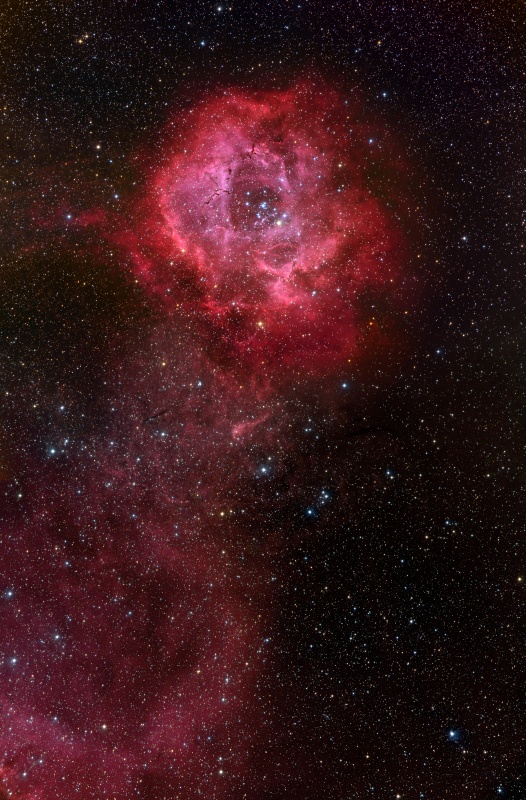 Тайлбар: Сарнай мананцар (NGC 2237) нь огторгуй дахь цэцэгтэй төстэй олон мананцруудын нэг юм. Гэхдээ уг мананцарын зураг нь Гэгээн Валентины баярт илүү сайн тохирох юм. Өдрийн одон орны зураг хөтөлбөрт ирсэн Сарнай мананцрын зургууд дотроос гэрэлтэж байгаа устөрөгчийн хийгээс бүтсэн урт иш бүхий энэ зураг хамгийн тохиромжтой нь байлаа. Уг мананцар нь Ганц эвэртийн одны ордны асар том молекулын үүлний захад 5000 гэрлийн жилийн алсад байрлана. Сансрын энэ сарнайн дэлбээнүүд нь оддын өлгий бөгөөд тэгш хэмтэй хэлбэр нь төвд байгаа залуу, халуун оддын бөөгнөрлөөс гарах цацраг туяа, салхиар үүсгэгдэнэ. NGC 2244 гэж бүртгэгдсэн уг бөөгнөрлийн оддын нас нь хэдхэн сая жил бөгөөд төв хэсгийн хэмжээ нь 50 гэрлийн жил юм. Гэгээн Валентины өдрийн мэнд хүргэе!
Тайлбар: Сарнай мананцар (NGC 2237) нь огторгуй дахь цэцэгтэй төстэй олон мананцруудын нэг юм. Гэхдээ уг мананцарын зураг нь Гэгээн Валентины баярт илүү сайн тохирох юм. Өдрийн одон орны зураг хөтөлбөрт ирсэн Сарнай мананцрын зургууд дотроос гэрэлтэж байгаа устөрөгчийн хийгээс бүтсэн урт иш бүхий энэ зураг хамгийн тохиромжтой нь байлаа. Уг мананцар нь Ганц эвэртийн одны ордны асар том молекулын үүлний захад 5000 гэрлийн жилийн алсад байрлана. Сансрын энэ сарнайн дэлбээнүүд нь оддын өлгий бөгөөд тэгш хэмтэй хэлбэр нь төвд байгаа залуу, халуун оддын бөөгнөрлөөс гарах цацраг туяа, салхиар үүсгэгдэнэ. NGC 2244 гэж бүртгэгдсэн уг бөөгнөрлийн оддын нас нь хэдхэн сая жил бөгөөд төв хэсгийн хэмжээ нь 50 гэрлийн жил юм. Гэгээн Валентины өдрийн мэнд хүргэе!Explanation: The Rosette Nebula (aka NGC 2237) is not the only cosmic cloud of gas and dust to evoke the imagery of flowers. But it is the one most often suggested as a suitable astronomy image for Valentine's Day. Of the many excellent Rosette Nebula pictures submitted to APOD editors, this view seemed most appropriate, with a long stem of glowing hydrogen gas in the region included in the composition. At the edge of a large molecular cloud in Monoceros, some 5,000 light years away, the petals of this rose are actually a stellar nursery whose lovely, symmetric shape is sculpted by the winds and radiation from its central cluster of hot young stars. The stars in the energetic cluster, cataloged as NGC 2244, are only a few million years old, while the central cavity in the Rosette Nebula is about 50 light-years in diameter. Happy Valentine's Day!
Пояснение: Туманность Розетка (NGC 2237) - это не единственное космическое облако из газа и пыли, похожее на цветы. Однако именно ее изображения чаще всего считают наиболее подходящими для Дня Св. Валентина. Из множества отличных изображений туманности Розетка, присланных редакторам Астрономической картинки дня, именно это кажется наиболее подходящим, так как в композицию включена и длинная "ножка" из светящегося водорода. Туманность находится на краю огромного молекулярного облака в Единороге, на расстоянии около 5 тысяч световых лет. Лепестки этой космической розы на самом деле - звездные ясли, а их красивая симметричная форма вылеплена ветрами и излучением центрального скопления из горячих молодых звезд. Возраст звезд этого скопления, занесенного в каталог как NGC 2244, всего несколько миллионов лет, а диаметр центральной полости туманности Розетка - около 50 световых лет. Поздравляем всех с Днем Св. Валентина!
Keine Kommentare:
Kommentar veröffentlichen